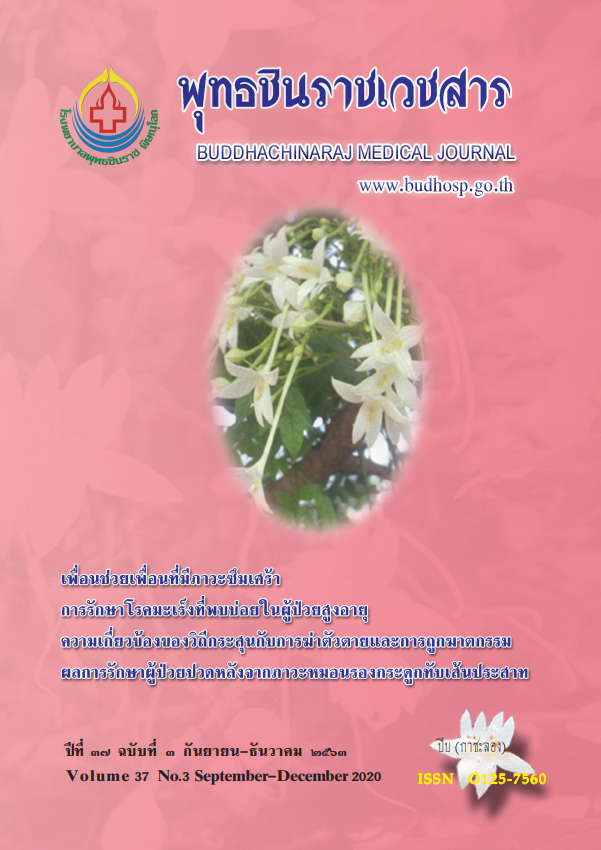การพัฒนาระบบการคัดกรองโรคเบาหวานและโรคความดันโลหิตสูงโดยอาศัย การมีส่วนร่วมของภาคีเครือข่ายชุมชนเมืองในคลินิกหมอครอบครัว
การพัฒนาระบบการคัดกรองโรคเบาหวานและโรคความดันโลหิตสูง
คำสำคัญ:
การคัดกรองโรค, โรคเบาหวาน, โรคความดันโลหิตสูง, การมีส่วนร่วมภาคีเครือข่าย, คลินิก หมอครอบครัวบทคัดย่อ
กระทรวงสาธารณสุขได้ปฏิรูปรูปแบบการคัดกรองโรคไม่ติดต่อในกลุ่มประชากรทั่วไปเน้นการพัฒนากลไกที่ภาคีเครือข่ายมีส่วนร่วม อย่างมีประสิทธิผล การศึกษานี้เป็นการวิจัยเชิงปฏิบัติการตามหลักการ PAOR 4 ขั้นตอน ได้แก่ 1) Plan คือ วางแผนหลังวิเคราะห์ ปัญหา 2) Act คือ ลงมือปฏิบัติ 3) Observer คือ สังเกตผลที่เกิดขึ้น 4) Reflect คือ สะท้อนผลหลังปฏิบัติเพื่อแก้ไข โดยมีวัตถุประสงค์เพื่อพัฒนาระบบการคัดกรองโรคเบาหวานและโรคความดันโลหิตสูงด้วยการมีส่วนร่วมของภาคีเครือข่ายระหว่าง ปีงบประมาณ 2559-2561 ในประชากรอายุ 35 ปี ขึ้นไปที่อาศัยอยู่ในเขตเทศบาลนครพิษณุโลกซึ่งได้รับการตรวจคัดกรองโรคเบา หวานและโรคความดันโลหิตสูงด้วยการเจาะน้ำตาลปลายนิ้วและการวัดความดันโลหิต ทั้งนี้ระบบการคัดกรองที่ได้พัฒนาประกอบ ด้วยการเพิ่มความครอบคลุมการให้บริการคัดกรองเชิงรับในคลินิกหมอครอบครัว การเพิ่มการให้บริการคัดกรองเชิงรุกในชุมชนทั้ง ในและนอกเวลาราชการโดยการมีส่วนร่วมของภาคีเครือข่ายพบว่าในปีงบประมาณ 2559 ประชาชนที่มีอายุ 35 ปีขึ้นไปได้รับการคัด กรองโรคเบาหวานร้อยละ 6.3 และเพิ่มเป็นร้อยละ 16.6 ในปีงบประมาณ 2561 อีกทั้ง ได้รับการคัดกรองโรคความดันโลหิตสูงเพิ่ม ขึ้นจากร้อยละ 5.4 เป็นร้อยละ 18.9 ตามลำดับ นั่นคือการพัฒนานี้ ทำให้ประชาชนในเขตชุมชนเมืองได้รับการคัดกรองโรคเบา หวานและโรคความดันโลหิตสูงเพิ่มขึ้น
เอกสารอ้างอิง
2. Strategy and Planning Group, Bureau of Non Communicable Disease. Annual Report 2015. Bangkok, Thailand: Bureau of Non Communicable Disease, Ministry of Public Health; 2016.
3. Bureau of Non Communicable Disease, Ministry of Public Health. Non-communicable disease control plan 2017-2021 [Internet]. [n.d.] [cited 2020 Dec 2]. Available from:http://plan.ddc.moph.go.th/meeting30_1augsep/meetting30_1/Documents/
7.%20NATI/1.%E0%B9%81%E0%B8%9C%E0%B8%99%E0%B8%87%E0%B8%B2%E0%B8%99%E0%B8%84%E0%B8%A7%E0% B8%9A%E0%B8%84%E0%B8%B8%E0% B8%A1%E0%B9%
4. Bureau of Non Communicable Disease. Annual Report 2012. Bangkok, Thailand:Bureau of Non Communicable Disease;2013.
5. Department of Disease Control. Situation on NCDs prevention and control in Thailand [Internet]. 2018 [cited 2020 May10]. Available from: http://www.thaincd.com/document/file/download/paper-manual/NCDUNIATF61.pdf
6. Sapsirisopa K. The renal complication screening development of patients with high blood pressure, Muang Nongkhai District, Nongkhai Province. EAU Heritage J Sci Technol 2017;11(2):207-14.
7. Armartmuntree T. The development of a diabetic care system in Kuchan Health Promoting Hospital, Kham Khuean Kaeo District, Yasothon Province. Kuakarun J Nurs 2016;23(2):69-85.
8. Sawangsri W. The development of health promotion model for prevention new cases of diabetes mellitus in community. JR Thai Army Nurs 2015;16(1):116-22.
9. Bureau of Non Communicable Disease. Indicators [Internet]. 2009 [cited 2020 Dec 8]. Available from: http://www.thaincd.com/document/file/info/non-communicabledisease/template%E0%B8%95%E0%B8%B1%E0%B8%A7%E0%B8%8A%E0%B8%
B5%E0%B9%89%E0%B8%A7%E0%B8%B1%E0%B8%94_%E0%B8%81%E0%B8% 97.%E0%B8%97%E0%B8%B5%E0%B9%88_NCD%E0%B8%A3%E0%B8%B1%E0%B8%9A%E0%B8%9C%E0%B8%B4%E0%B8%94%E0%B8%8A%E0% B8%AD%E0%B8%9A_.docx
10. Phitsanulok Provincial Health Office. Health Data Center [Internet]. [n.d.] [cited 2020 Dec 8]. Available from: https://plk.hdc.moph.go.th/hdc/reports/report.php?source=pformated/format1.php&cat_id=6966b0664b89805a484d7ac96c6edc48&id=
6833128a5d76a6afcae3e4a6af0e718c
11. Paimoolpiam P. Model development to improve accessibility of diabetes and hypertension patients with participation of community network, Maesakorn Health Promoting Hospital, Wiang Sa District, Nan Province. J Health Sci 2016;25(3):394-9.
12. Bureau of Non Communicable Disease, Department of Disease Control. Guideline operation of non-communicable disease control prevention by community based intervention: CBI [Internet]. 2009 [cited 2020
May 10]. Available from: http://www.thaincd.com/document/file/download/paper-manual/download1no245.pdf
13. MGR Online. Proactive service of family care team health care couselling [Internet]. 2015 [cited 2020 May 29]. Available from:https://mgronline.com/goodhealth/detail/9580000066379
14. Chompun J. The public participation analysis in "The Public Participation Handbook: Marking Better Decisions through Citizen Involvement" in Thailand. J Environ Manage 2012;8(1):123-41.
15. Wisutisiri S. Development of screening of the risks for foot ulcer in diabetic patients, Khonburi Hospital, Nakhon Ratchasima Province. J Boromarajonani Coll Nurs, Nakhonratchasima 2010;16(1):60-73.
16. Jarungjittanuson S. Development of surveillance and promotion model for early childhood with developmental delay in Buriram Province. J Nurs Health Care 2017;35(2):122-32.
17. Chadthorng J. Effects of the 333's visual screening models in community for prevention of blindness from cataract: Loengnoktha District, Yasothon Province. Thammasat Univ Hosp J 2018;3(3):10-8.
18. Strategy and Planning Division, Ministry of Public Health. Strategic of health service system of urban area (2018-2027) [Internet]. 2019 [cited 2020 May 10].Available from: http://bps.moph.go.th/new_bps/sites/default/files/Draft%20Urban%
20Strategies301160_EP2.pdf






